Creativity, Innovation, and Design Thinking Essay for Management 7
VerifiedAdded on 2022/08/14
|8
|2630
|16
Essay
AI Summary
This essay examines the relationship between individual efforts and organizational creativity, innovation, and design thinking, arguing that team collaboration is more critical than individual contributions. The essay defines these concepts and explores relevant theories, including the interactionist perspective and the componential theory of creativity. Real-world examples from companies like Microsoft and 3M are used to support the argument, highlighting how these organizations foster innovation through employee collaboration and design thinking processes. The essay emphasizes the importance of cross-functional teams, user-centric approaches, and the integration of design principles to achieve successful innovation. It concludes that effective creativity, innovation, and design thinking require team efforts, leading to rapid adaptation in a dynamic business environment.
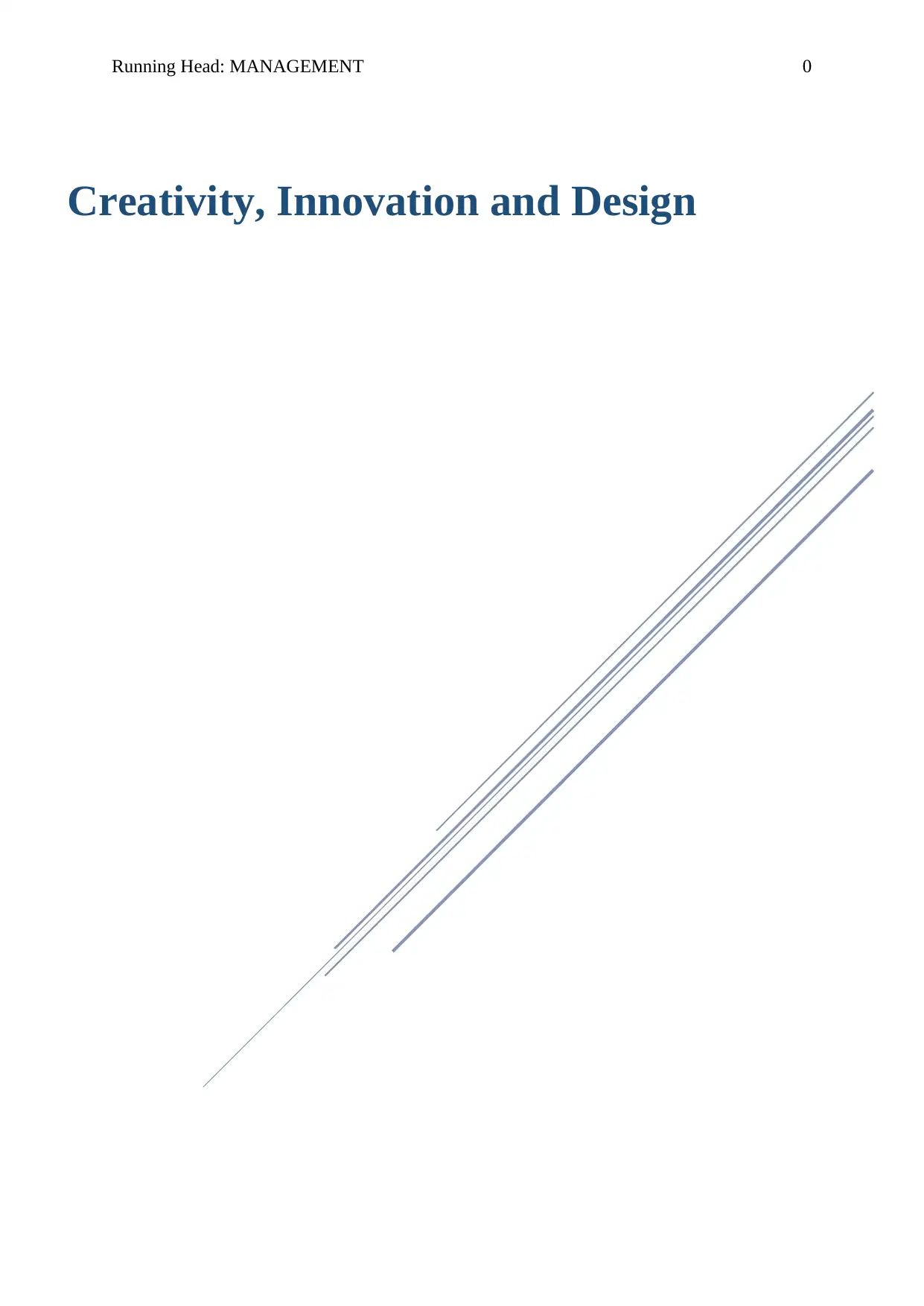
Running Head: MANAGEMENT 0
Creativity, Innovation and Design
Creativity, Innovation and Design
Paraphrase This Document
Need a fresh take? Get an instant paraphrase of this document with our AI Paraphraser
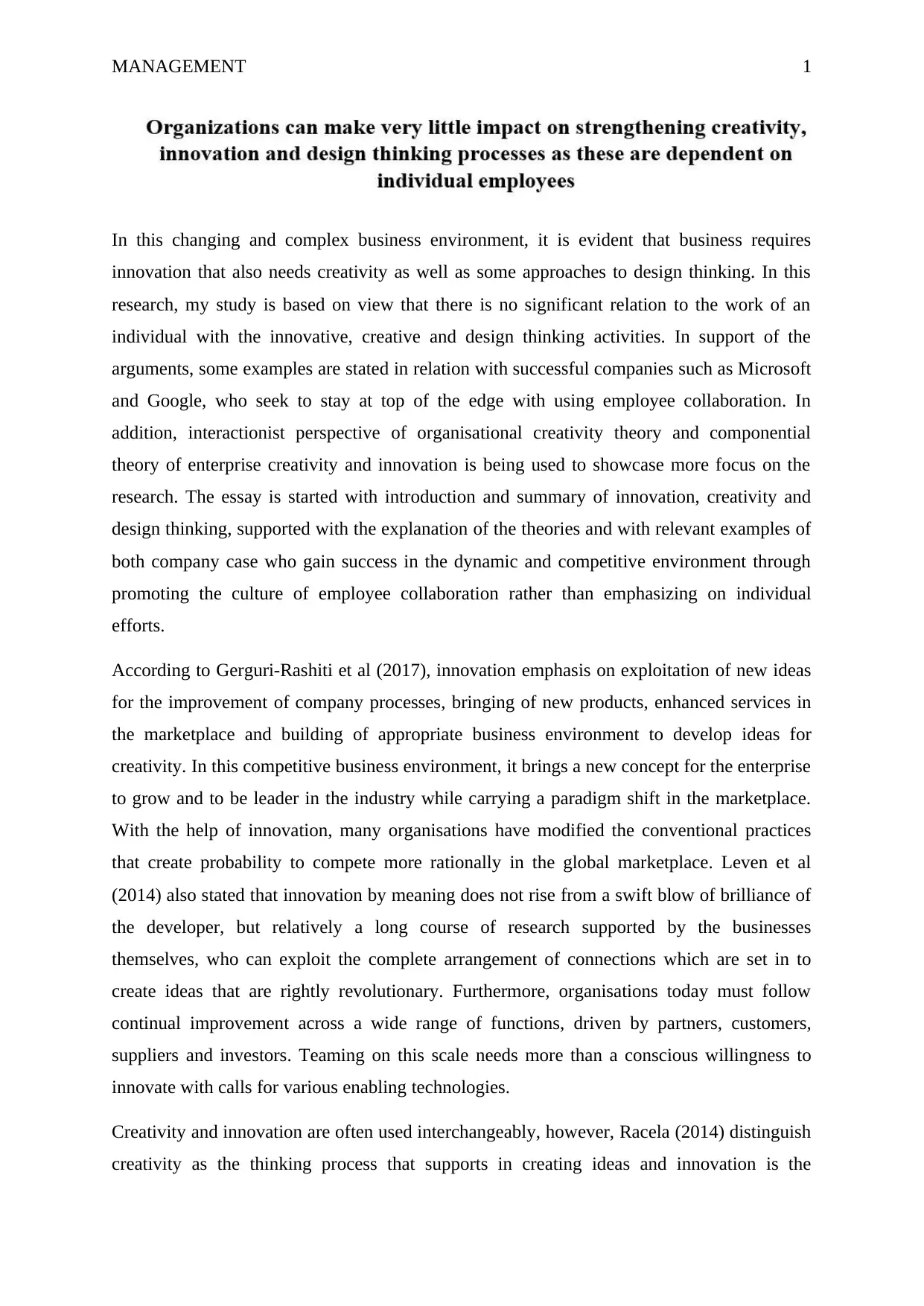
MANAGEMENT 1
In this changing and complex business environment, it is evident that business requires
innovation that also needs creativity as well as some approaches to design thinking. In this
research, my study is based on view that there is no significant relation to the work of an
individual with the innovative, creative and design thinking activities. In support of the
arguments, some examples are stated in relation with successful companies such as Microsoft
and Google, who seek to stay at top of the edge with using employee collaboration. In
addition, interactionist perspective of organisational creativity theory and componential
theory of enterprise creativity and innovation is being used to showcase more focus on the
research. The essay is started with introduction and summary of innovation, creativity and
design thinking, supported with the explanation of the theories and with relevant examples of
both company case who gain success in the dynamic and competitive environment through
promoting the culture of employee collaboration rather than emphasizing on individual
efforts.
According to Gerguri‐Rashiti et al (2017), innovation emphasis on exploitation of new ideas
for the improvement of company processes, bringing of new products, enhanced services in
the marketplace and building of appropriate business environment to develop ideas for
creativity. In this competitive business environment, it brings a new concept for the enterprise
to grow and to be leader in the industry while carrying a paradigm shift in the marketplace.
With the help of innovation, many organisations have modified the conventional practices
that create probability to compete more rationally in the global marketplace. Leven et al
(2014) also stated that innovation by meaning does not rise from a swift blow of brilliance of
the developer, but relatively a long course of research supported by the businesses
themselves, who can exploit the complete arrangement of connections which are set in to
create ideas that are rightly revolutionary. Furthermore, organisations today must follow
continual improvement across a wide range of functions, driven by partners, customers,
suppliers and investors. Teaming on this scale needs more than a conscious willingness to
innovate with calls for various enabling technologies.
Creativity and innovation are often used interchangeably, however, Racela (2014) distinguish
creativity as the thinking process that supports in creating ideas and innovation is the
In this changing and complex business environment, it is evident that business requires
innovation that also needs creativity as well as some approaches to design thinking. In this
research, my study is based on view that there is no significant relation to the work of an
individual with the innovative, creative and design thinking activities. In support of the
arguments, some examples are stated in relation with successful companies such as Microsoft
and Google, who seek to stay at top of the edge with using employee collaboration. In
addition, interactionist perspective of organisational creativity theory and componential
theory of enterprise creativity and innovation is being used to showcase more focus on the
research. The essay is started with introduction and summary of innovation, creativity and
design thinking, supported with the explanation of the theories and with relevant examples of
both company case who gain success in the dynamic and competitive environment through
promoting the culture of employee collaboration rather than emphasizing on individual
efforts.
According to Gerguri‐Rashiti et al (2017), innovation emphasis on exploitation of new ideas
for the improvement of company processes, bringing of new products, enhanced services in
the marketplace and building of appropriate business environment to develop ideas for
creativity. In this competitive business environment, it brings a new concept for the enterprise
to grow and to be leader in the industry while carrying a paradigm shift in the marketplace.
With the help of innovation, many organisations have modified the conventional practices
that create probability to compete more rationally in the global marketplace. Leven et al
(2014) also stated that innovation by meaning does not rise from a swift blow of brilliance of
the developer, but relatively a long course of research supported by the businesses
themselves, who can exploit the complete arrangement of connections which are set in to
create ideas that are rightly revolutionary. Furthermore, organisations today must follow
continual improvement across a wide range of functions, driven by partners, customers,
suppliers and investors. Teaming on this scale needs more than a conscious willingness to
innovate with calls for various enabling technologies.
Creativity and innovation are often used interchangeably, however, Racela (2014) distinguish
creativity as the thinking process that supports in creating ideas and innovation is the
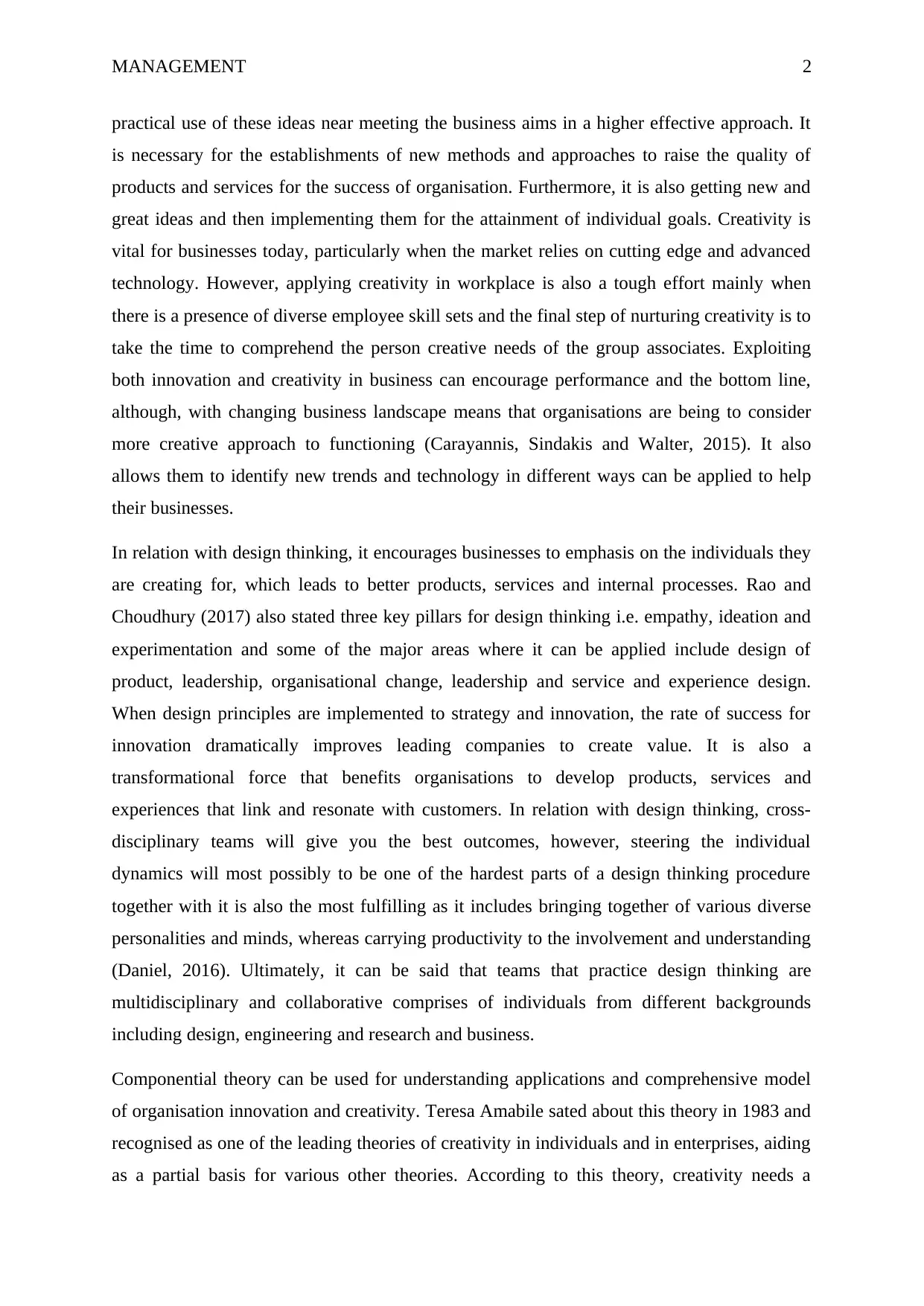
MANAGEMENT 2
practical use of these ideas near meeting the business aims in a higher effective approach. It
is necessary for the establishments of new methods and approaches to raise the quality of
products and services for the success of organisation. Furthermore, it is also getting new and
great ideas and then implementing them for the attainment of individual goals. Creativity is
vital for businesses today, particularly when the market relies on cutting edge and advanced
technology. However, applying creativity in workplace is also a tough effort mainly when
there is a presence of diverse employee skill sets and the final step of nurturing creativity is to
take the time to comprehend the person creative needs of the group associates. Exploiting
both innovation and creativity in business can encourage performance and the bottom line,
although, with changing business landscape means that organisations are being to consider
more creative approach to functioning (Carayannis, Sindakis and Walter, 2015). It also
allows them to identify new trends and technology in different ways can be applied to help
their businesses.
In relation with design thinking, it encourages businesses to emphasis on the individuals they
are creating for, which leads to better products, services and internal processes. Rao and
Choudhury (2017) also stated three key pillars for design thinking i.e. empathy, ideation and
experimentation and some of the major areas where it can be applied include design of
product, leadership, organisational change, leadership and service and experience design.
When design principles are implemented to strategy and innovation, the rate of success for
innovation dramatically improves leading companies to create value. It is also a
transformational force that benefits organisations to develop products, services and
experiences that link and resonate with customers. In relation with design thinking, cross-
disciplinary teams will give you the best outcomes, however, steering the individual
dynamics will most possibly to be one of the hardest parts of a design thinking procedure
together with it is also the most fulfilling as it includes bringing together of various diverse
personalities and minds, whereas carrying productivity to the involvement and understanding
(Daniel, 2016). Ultimately, it can be said that teams that practice design thinking are
multidisciplinary and collaborative comprises of individuals from different backgrounds
including design, engineering and research and business.
Componential theory can be used for understanding applications and comprehensive model
of organisation innovation and creativity. Teresa Amabile sated about this theory in 1983 and
recognised as one of the leading theories of creativity in individuals and in enterprises, aiding
as a partial basis for various other theories. According to this theory, creativity needs a
practical use of these ideas near meeting the business aims in a higher effective approach. It
is necessary for the establishments of new methods and approaches to raise the quality of
products and services for the success of organisation. Furthermore, it is also getting new and
great ideas and then implementing them for the attainment of individual goals. Creativity is
vital for businesses today, particularly when the market relies on cutting edge and advanced
technology. However, applying creativity in workplace is also a tough effort mainly when
there is a presence of diverse employee skill sets and the final step of nurturing creativity is to
take the time to comprehend the person creative needs of the group associates. Exploiting
both innovation and creativity in business can encourage performance and the bottom line,
although, with changing business landscape means that organisations are being to consider
more creative approach to functioning (Carayannis, Sindakis and Walter, 2015). It also
allows them to identify new trends and technology in different ways can be applied to help
their businesses.
In relation with design thinking, it encourages businesses to emphasis on the individuals they
are creating for, which leads to better products, services and internal processes. Rao and
Choudhury (2017) also stated three key pillars for design thinking i.e. empathy, ideation and
experimentation and some of the major areas where it can be applied include design of
product, leadership, organisational change, leadership and service and experience design.
When design principles are implemented to strategy and innovation, the rate of success for
innovation dramatically improves leading companies to create value. It is also a
transformational force that benefits organisations to develop products, services and
experiences that link and resonate with customers. In relation with design thinking, cross-
disciplinary teams will give you the best outcomes, however, steering the individual
dynamics will most possibly to be one of the hardest parts of a design thinking procedure
together with it is also the most fulfilling as it includes bringing together of various diverse
personalities and minds, whereas carrying productivity to the involvement and understanding
(Daniel, 2016). Ultimately, it can be said that teams that practice design thinking are
multidisciplinary and collaborative comprises of individuals from different backgrounds
including design, engineering and research and business.
Componential theory can be used for understanding applications and comprehensive model
of organisation innovation and creativity. Teresa Amabile sated about this theory in 1983 and
recognised as one of the leading theories of creativity in individuals and in enterprises, aiding
as a partial basis for various other theories. According to this theory, creativity needs a
⊘ This is a preview!⊘
Do you want full access?
Subscribe today to unlock all pages.

Trusted by 1+ million students worldwide
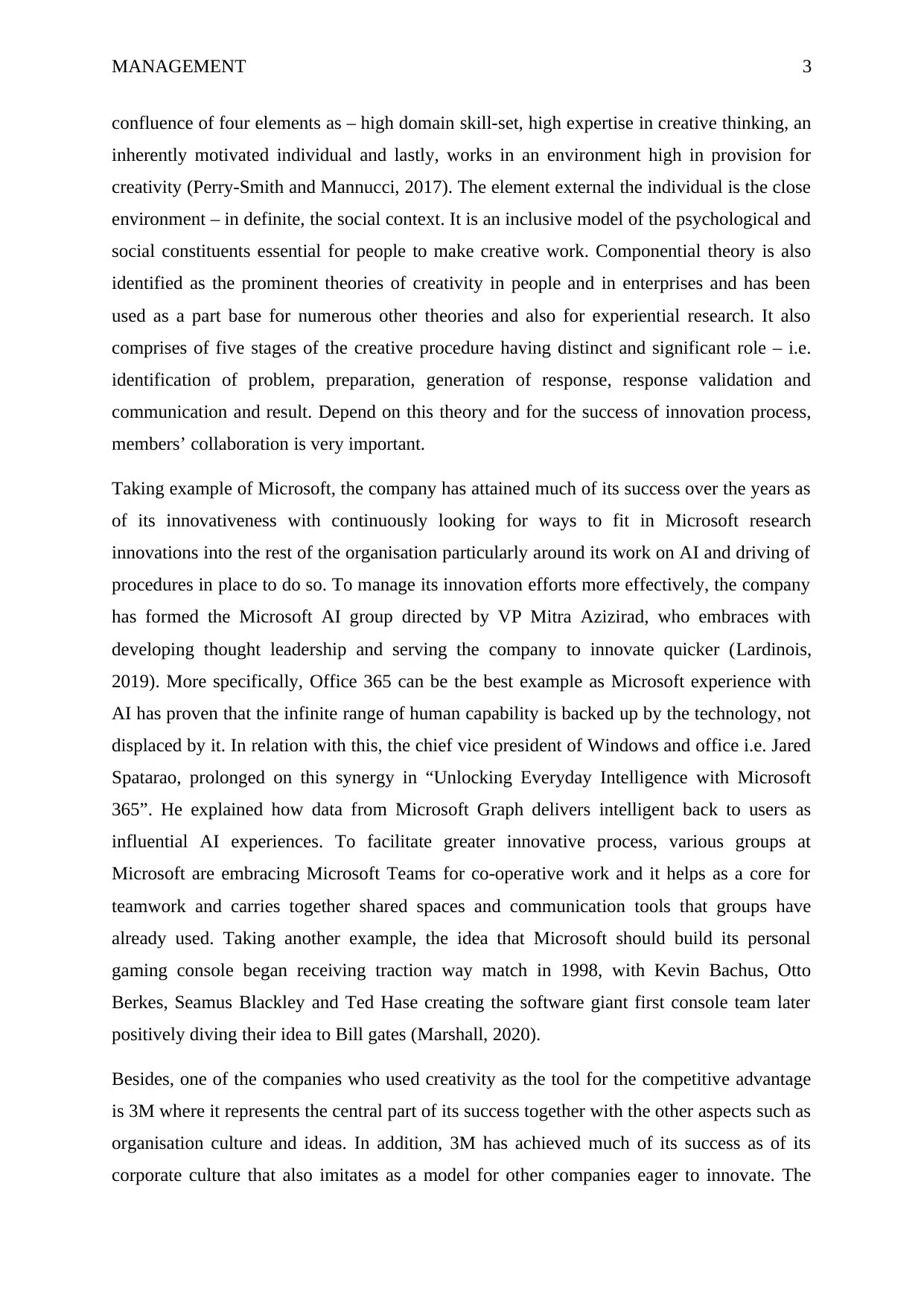
MANAGEMENT 3
confluence of four elements as – high domain skill-set, high expertise in creative thinking, an
inherently motivated individual and lastly, works in an environment high in provision for
creativity (Perry-Smith and Mannucci, 2017). The element external the individual is the close
environment – in definite, the social context. It is an inclusive model of the psychological and
social constituents essential for people to make creative work. Componential theory is also
identified as the prominent theories of creativity in people and in enterprises and has been
used as a part base for numerous other theories and also for experiential research. It also
comprises of five stages of the creative procedure having distinct and significant role – i.e.
identification of problem, preparation, generation of response, response validation and
communication and result. Depend on this theory and for the success of innovation process,
members’ collaboration is very important.
Taking example of Microsoft, the company has attained much of its success over the years as
of its innovativeness with continuously looking for ways to fit in Microsoft research
innovations into the rest of the organisation particularly around its work on AI and driving of
procedures in place to do so. To manage its innovation efforts more effectively, the company
has formed the Microsoft AI group directed by VP Mitra Azizirad, who embraces with
developing thought leadership and serving the company to innovate quicker (Lardinois,
2019). More specifically, Office 365 can be the best example as Microsoft experience with
AI has proven that the infinite range of human capability is backed up by the technology, not
displaced by it. In relation with this, the chief vice president of Windows and office i.e. Jared
Spatarao, prolonged on this synergy in “Unlocking Everyday Intelligence with Microsoft
365”. He explained how data from Microsoft Graph delivers intelligent back to users as
influential AI experiences. To facilitate greater innovative process, various groups at
Microsoft are embracing Microsoft Teams for co-operative work and it helps as a core for
teamwork and carries together shared spaces and communication tools that groups have
already used. Taking another example, the idea that Microsoft should build its personal
gaming console began receiving traction way match in 1998, with Kevin Bachus, Otto
Berkes, Seamus Blackley and Ted Hase creating the software giant first console team later
positively diving their idea to Bill gates (Marshall, 2020).
Besides, one of the companies who used creativity as the tool for the competitive advantage
is 3M where it represents the central part of its success together with the other aspects such as
organisation culture and ideas. In addition, 3M has achieved much of its success as of its
corporate culture that also imitates as a model for other companies eager to innovate. The
confluence of four elements as – high domain skill-set, high expertise in creative thinking, an
inherently motivated individual and lastly, works in an environment high in provision for
creativity (Perry-Smith and Mannucci, 2017). The element external the individual is the close
environment – in definite, the social context. It is an inclusive model of the psychological and
social constituents essential for people to make creative work. Componential theory is also
identified as the prominent theories of creativity in people and in enterprises and has been
used as a part base for numerous other theories and also for experiential research. It also
comprises of five stages of the creative procedure having distinct and significant role – i.e.
identification of problem, preparation, generation of response, response validation and
communication and result. Depend on this theory and for the success of innovation process,
members’ collaboration is very important.
Taking example of Microsoft, the company has attained much of its success over the years as
of its innovativeness with continuously looking for ways to fit in Microsoft research
innovations into the rest of the organisation particularly around its work on AI and driving of
procedures in place to do so. To manage its innovation efforts more effectively, the company
has formed the Microsoft AI group directed by VP Mitra Azizirad, who embraces with
developing thought leadership and serving the company to innovate quicker (Lardinois,
2019). More specifically, Office 365 can be the best example as Microsoft experience with
AI has proven that the infinite range of human capability is backed up by the technology, not
displaced by it. In relation with this, the chief vice president of Windows and office i.e. Jared
Spatarao, prolonged on this synergy in “Unlocking Everyday Intelligence with Microsoft
365”. He explained how data from Microsoft Graph delivers intelligent back to users as
influential AI experiences. To facilitate greater innovative process, various groups at
Microsoft are embracing Microsoft Teams for co-operative work and it helps as a core for
teamwork and carries together shared spaces and communication tools that groups have
already used. Taking another example, the idea that Microsoft should build its personal
gaming console began receiving traction way match in 1998, with Kevin Bachus, Otto
Berkes, Seamus Blackley and Ted Hase creating the software giant first console team later
positively diving their idea to Bill gates (Marshall, 2020).
Besides, one of the companies who used creativity as the tool for the competitive advantage
is 3M where it represents the central part of its success together with the other aspects such as
organisation culture and ideas. In addition, 3M has achieved much of its success as of its
corporate culture that also imitates as a model for other companies eager to innovate. The
Paraphrase This Document
Need a fresh take? Get an instant paraphrase of this document with our AI Paraphraser
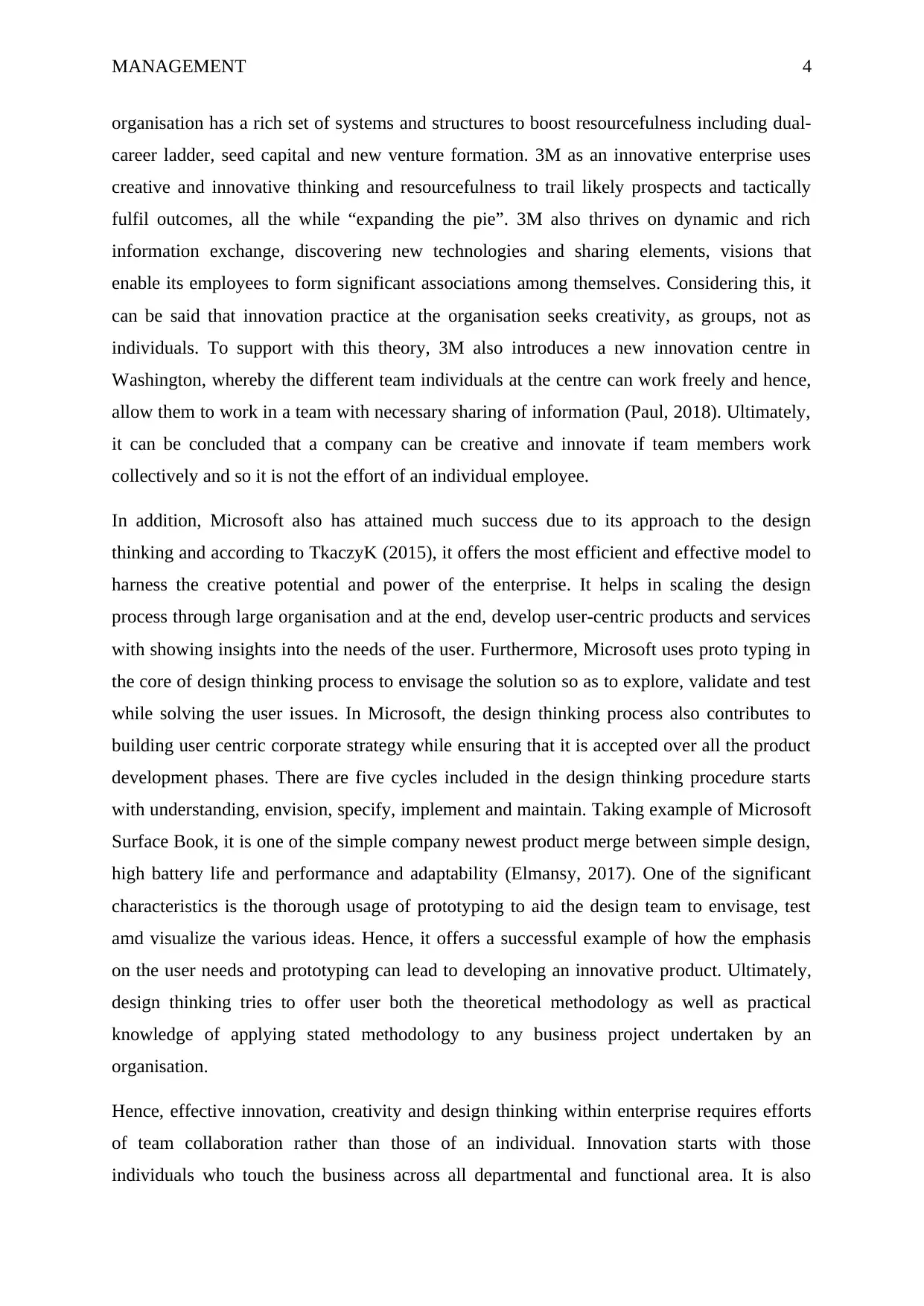
MANAGEMENT 4
organisation has a rich set of systems and structures to boost resourcefulness including dual-
career ladder, seed capital and new venture formation. 3M as an innovative enterprise uses
creative and innovative thinking and resourcefulness to trail likely prospects and tactically
fulfil outcomes, all the while “expanding the pie”. 3M also thrives on dynamic and rich
information exchange, discovering new technologies and sharing elements, visions that
enable its employees to form significant associations among themselves. Considering this, it
can be said that innovation practice at the organisation seeks creativity, as groups, not as
individuals. To support with this theory, 3M also introduces a new innovation centre in
Washington, whereby the different team individuals at the centre can work freely and hence,
allow them to work in a team with necessary sharing of information (Paul, 2018). Ultimately,
it can be concluded that a company can be creative and innovate if team members work
collectively and so it is not the effort of an individual employee.
In addition, Microsoft also has attained much success due to its approach to the design
thinking and according to TkaczyK (2015), it offers the most efficient and effective model to
harness the creative potential and power of the enterprise. It helps in scaling the design
process through large organisation and at the end, develop user-centric products and services
with showing insights into the needs of the user. Furthermore, Microsoft uses proto typing in
the core of design thinking process to envisage the solution so as to explore, validate and test
while solving the user issues. In Microsoft, the design thinking process also contributes to
building user centric corporate strategy while ensuring that it is accepted over all the product
development phases. There are five cycles included in the design thinking procedure starts
with understanding, envision, specify, implement and maintain. Taking example of Microsoft
Surface Book, it is one of the simple company newest product merge between simple design,
high battery life and performance and adaptability (Elmansy, 2017). One of the significant
characteristics is the thorough usage of prototyping to aid the design team to envisage, test
amd visualize the various ideas. Hence, it offers a successful example of how the emphasis
on the user needs and prototyping can lead to developing an innovative product. Ultimately,
design thinking tries to offer user both the theoretical methodology as well as practical
knowledge of applying stated methodology to any business project undertaken by an
organisation.
Hence, effective innovation, creativity and design thinking within enterprise requires efforts
of team collaboration rather than those of an individual. Innovation starts with those
individuals who touch the business across all departmental and functional area. It is also
organisation has a rich set of systems and structures to boost resourcefulness including dual-
career ladder, seed capital and new venture formation. 3M as an innovative enterprise uses
creative and innovative thinking and resourcefulness to trail likely prospects and tactically
fulfil outcomes, all the while “expanding the pie”. 3M also thrives on dynamic and rich
information exchange, discovering new technologies and sharing elements, visions that
enable its employees to form significant associations among themselves. Considering this, it
can be said that innovation practice at the organisation seeks creativity, as groups, not as
individuals. To support with this theory, 3M also introduces a new innovation centre in
Washington, whereby the different team individuals at the centre can work freely and hence,
allow them to work in a team with necessary sharing of information (Paul, 2018). Ultimately,
it can be concluded that a company can be creative and innovate if team members work
collectively and so it is not the effort of an individual employee.
In addition, Microsoft also has attained much success due to its approach to the design
thinking and according to TkaczyK (2015), it offers the most efficient and effective model to
harness the creative potential and power of the enterprise. It helps in scaling the design
process through large organisation and at the end, develop user-centric products and services
with showing insights into the needs of the user. Furthermore, Microsoft uses proto typing in
the core of design thinking process to envisage the solution so as to explore, validate and test
while solving the user issues. In Microsoft, the design thinking process also contributes to
building user centric corporate strategy while ensuring that it is accepted over all the product
development phases. There are five cycles included in the design thinking procedure starts
with understanding, envision, specify, implement and maintain. Taking example of Microsoft
Surface Book, it is one of the simple company newest product merge between simple design,
high battery life and performance and adaptability (Elmansy, 2017). One of the significant
characteristics is the thorough usage of prototyping to aid the design team to envisage, test
amd visualize the various ideas. Hence, it offers a successful example of how the emphasis
on the user needs and prototyping can lead to developing an innovative product. Ultimately,
design thinking tries to offer user both the theoretical methodology as well as practical
knowledge of applying stated methodology to any business project undertaken by an
organisation.
Hence, effective innovation, creativity and design thinking within enterprise requires efforts
of team collaboration rather than those of an individual. Innovation starts with those
individuals who touch the business across all departmental and functional area. It is also
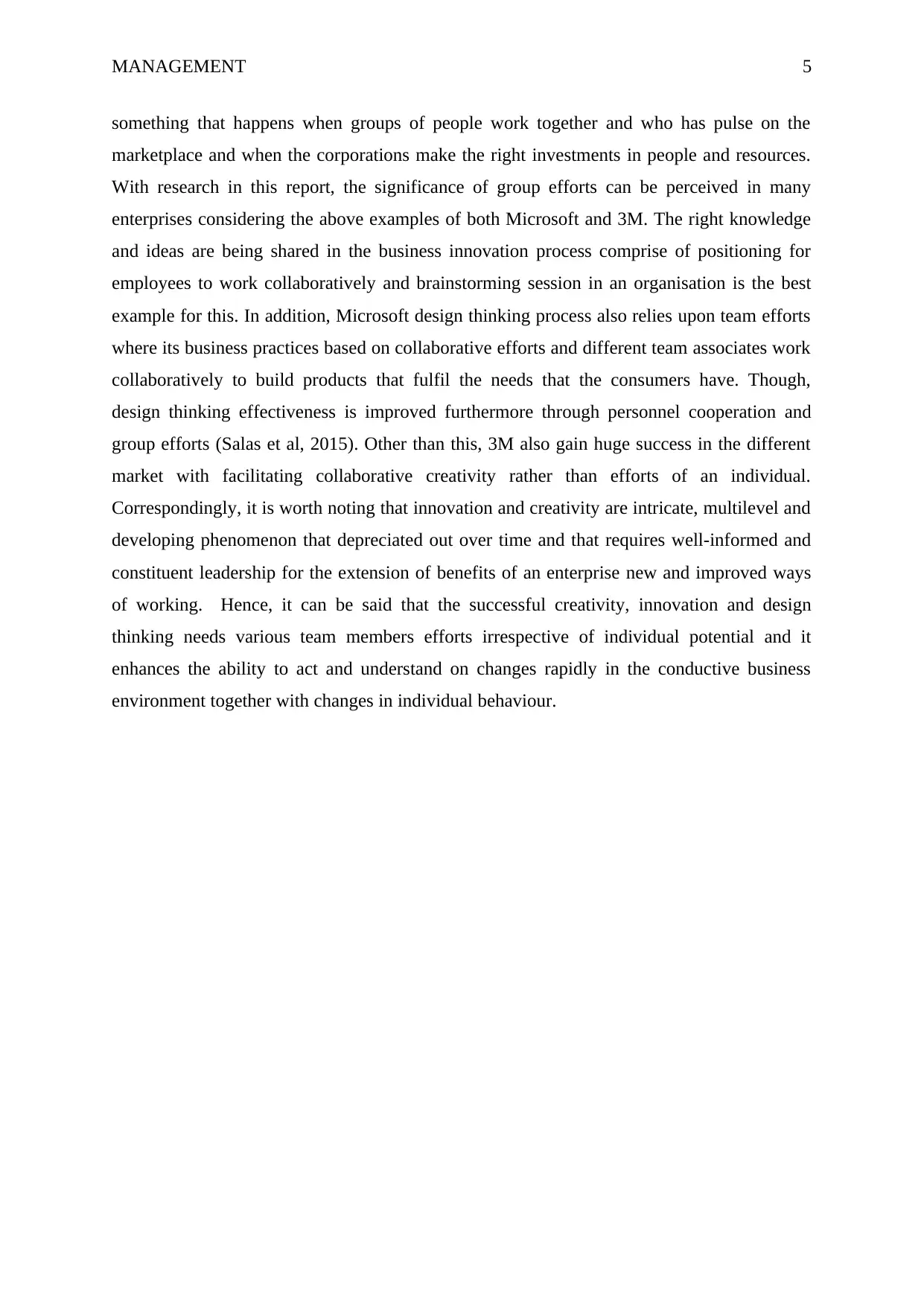
MANAGEMENT 5
something that happens when groups of people work together and who has pulse on the
marketplace and when the corporations make the right investments in people and resources.
With research in this report, the significance of group efforts can be perceived in many
enterprises considering the above examples of both Microsoft and 3M. The right knowledge
and ideas are being shared in the business innovation process comprise of positioning for
employees to work collaboratively and brainstorming session in an organisation is the best
example for this. In addition, Microsoft design thinking process also relies upon team efforts
where its business practices based on collaborative efforts and different team associates work
collaboratively to build products that fulfil the needs that the consumers have. Though,
design thinking effectiveness is improved furthermore through personnel cooperation and
group efforts (Salas et al, 2015). Other than this, 3M also gain huge success in the different
market with facilitating collaborative creativity rather than efforts of an individual.
Correspondingly, it is worth noting that innovation and creativity are intricate, multilevel and
developing phenomenon that depreciated out over time and that requires well-informed and
constituent leadership for the extension of benefits of an enterprise new and improved ways
of working. Hence, it can be said that the successful creativity, innovation and design
thinking needs various team members efforts irrespective of individual potential and it
enhances the ability to act and understand on changes rapidly in the conductive business
environment together with changes in individual behaviour.
something that happens when groups of people work together and who has pulse on the
marketplace and when the corporations make the right investments in people and resources.
With research in this report, the significance of group efforts can be perceived in many
enterprises considering the above examples of both Microsoft and 3M. The right knowledge
and ideas are being shared in the business innovation process comprise of positioning for
employees to work collaboratively and brainstorming session in an organisation is the best
example for this. In addition, Microsoft design thinking process also relies upon team efforts
where its business practices based on collaborative efforts and different team associates work
collaboratively to build products that fulfil the needs that the consumers have. Though,
design thinking effectiveness is improved furthermore through personnel cooperation and
group efforts (Salas et al, 2015). Other than this, 3M also gain huge success in the different
market with facilitating collaborative creativity rather than efforts of an individual.
Correspondingly, it is worth noting that innovation and creativity are intricate, multilevel and
developing phenomenon that depreciated out over time and that requires well-informed and
constituent leadership for the extension of benefits of an enterprise new and improved ways
of working. Hence, it can be said that the successful creativity, innovation and design
thinking needs various team members efforts irrespective of individual potential and it
enhances the ability to act and understand on changes rapidly in the conductive business
environment together with changes in individual behaviour.
⊘ This is a preview!⊘
Do you want full access?
Subscribe today to unlock all pages.

Trusted by 1+ million students worldwide
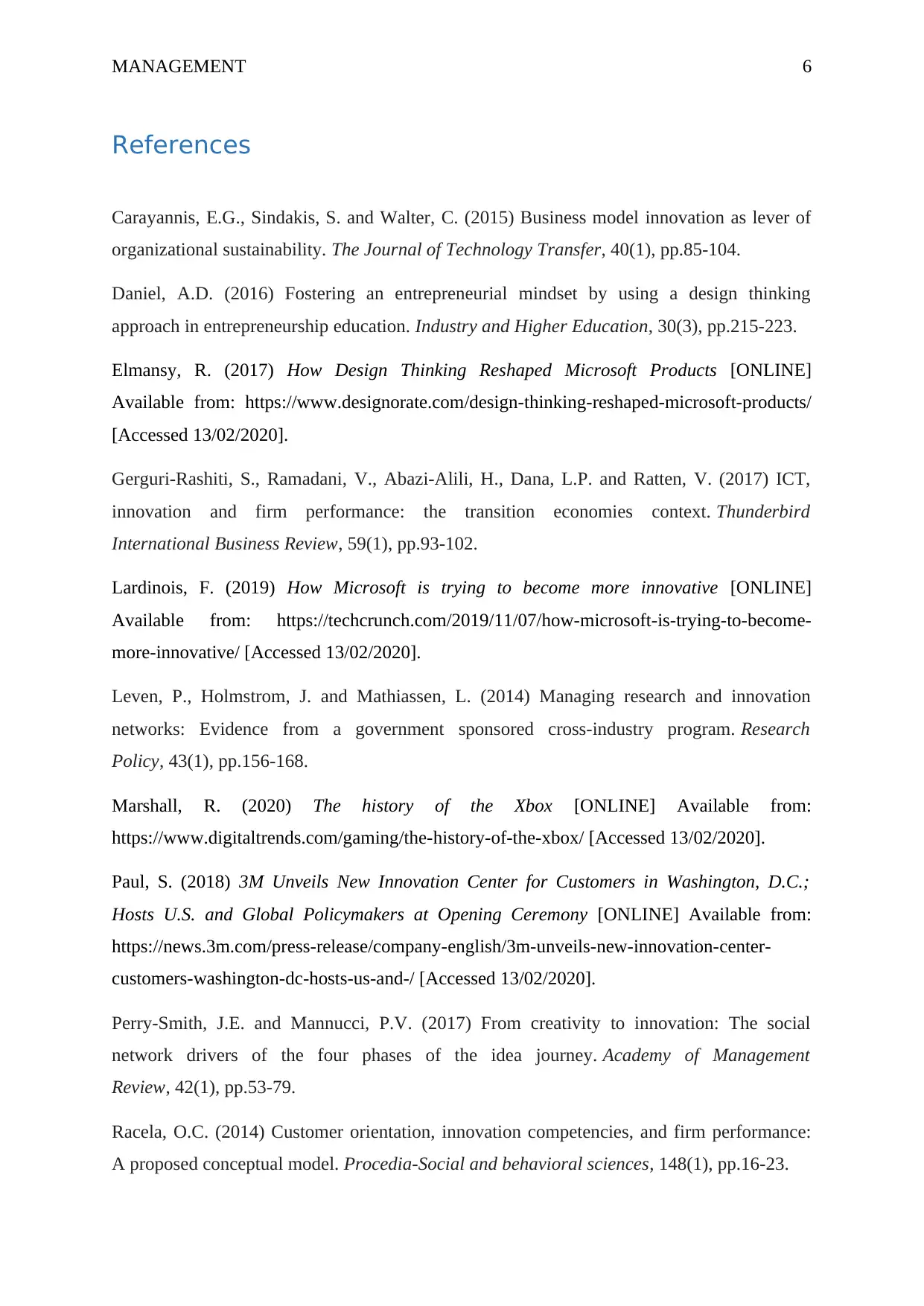
MANAGEMENT 6
References
Carayannis, E.G., Sindakis, S. and Walter, C. (2015) Business model innovation as lever of
organizational sustainability. The Journal of Technology Transfer, 40(1), pp.85-104.
Daniel, A.D. (2016) Fostering an entrepreneurial mindset by using a design thinking
approach in entrepreneurship education. Industry and Higher Education, 30(3), pp.215-223.
Elmansy, R. (2017) How Design Thinking Reshaped Microsoft Products [ONLINE]
Available from: https://www.designorate.com/design-thinking-reshaped-microsoft-products/
[Accessed 13/02/2020].
Gerguri‐Rashiti, S., Ramadani, V., Abazi‐Alili, H., Dana, L.P. and Ratten, V. (2017) ICT,
innovation and firm performance: the transition economies context. Thunderbird
International Business Review, 59(1), pp.93-102.
Lardinois, F. (2019) How Microsoft is trying to become more innovative [ONLINE]
Available from: https://techcrunch.com/2019/11/07/how-microsoft-is-trying-to-become-
more-innovative/ [Accessed 13/02/2020].
Leven, P., Holmstrom, J. and Mathiassen, L. (2014) Managing research and innovation
networks: Evidence from a government sponsored cross-industry program. Research
Policy, 43(1), pp.156-168.
Marshall, R. (2020) The history of the Xbox [ONLINE] Available from:
https://www.digitaltrends.com/gaming/the-history-of-the-xbox/ [Accessed 13/02/2020].
Paul, S. (2018) 3M Unveils New Innovation Center for Customers in Washington, D.C.;
Hosts U.S. and Global Policymakers at Opening Ceremony [ONLINE] Available from:
https://news.3m.com/press-release/company-english/3m-unveils-new-innovation-center-
customers-washington-dc-hosts-us-and-/ [Accessed 13/02/2020].
Perry-Smith, J.E. and Mannucci, P.V. (2017) From creativity to innovation: The social
network drivers of the four phases of the idea journey. Academy of Management
Review, 42(1), pp.53-79.
Racela, O.C. (2014) Customer orientation, innovation competencies, and firm performance:
A proposed conceptual model. Procedia-Social and behavioral sciences, 148(1), pp.16-23.
References
Carayannis, E.G., Sindakis, S. and Walter, C. (2015) Business model innovation as lever of
organizational sustainability. The Journal of Technology Transfer, 40(1), pp.85-104.
Daniel, A.D. (2016) Fostering an entrepreneurial mindset by using a design thinking
approach in entrepreneurship education. Industry and Higher Education, 30(3), pp.215-223.
Elmansy, R. (2017) How Design Thinking Reshaped Microsoft Products [ONLINE]
Available from: https://www.designorate.com/design-thinking-reshaped-microsoft-products/
[Accessed 13/02/2020].
Gerguri‐Rashiti, S., Ramadani, V., Abazi‐Alili, H., Dana, L.P. and Ratten, V. (2017) ICT,
innovation and firm performance: the transition economies context. Thunderbird
International Business Review, 59(1), pp.93-102.
Lardinois, F. (2019) How Microsoft is trying to become more innovative [ONLINE]
Available from: https://techcrunch.com/2019/11/07/how-microsoft-is-trying-to-become-
more-innovative/ [Accessed 13/02/2020].
Leven, P., Holmstrom, J. and Mathiassen, L. (2014) Managing research and innovation
networks: Evidence from a government sponsored cross-industry program. Research
Policy, 43(1), pp.156-168.
Marshall, R. (2020) The history of the Xbox [ONLINE] Available from:
https://www.digitaltrends.com/gaming/the-history-of-the-xbox/ [Accessed 13/02/2020].
Paul, S. (2018) 3M Unveils New Innovation Center for Customers in Washington, D.C.;
Hosts U.S. and Global Policymakers at Opening Ceremony [ONLINE] Available from:
https://news.3m.com/press-release/company-english/3m-unveils-new-innovation-center-
customers-washington-dc-hosts-us-and-/ [Accessed 13/02/2020].
Perry-Smith, J.E. and Mannucci, P.V. (2017) From creativity to innovation: The social
network drivers of the four phases of the idea journey. Academy of Management
Review, 42(1), pp.53-79.
Racela, O.C. (2014) Customer orientation, innovation competencies, and firm performance:
A proposed conceptual model. Procedia-Social and behavioral sciences, 148(1), pp.16-23.
Paraphrase This Document
Need a fresh take? Get an instant paraphrase of this document with our AI Paraphraser
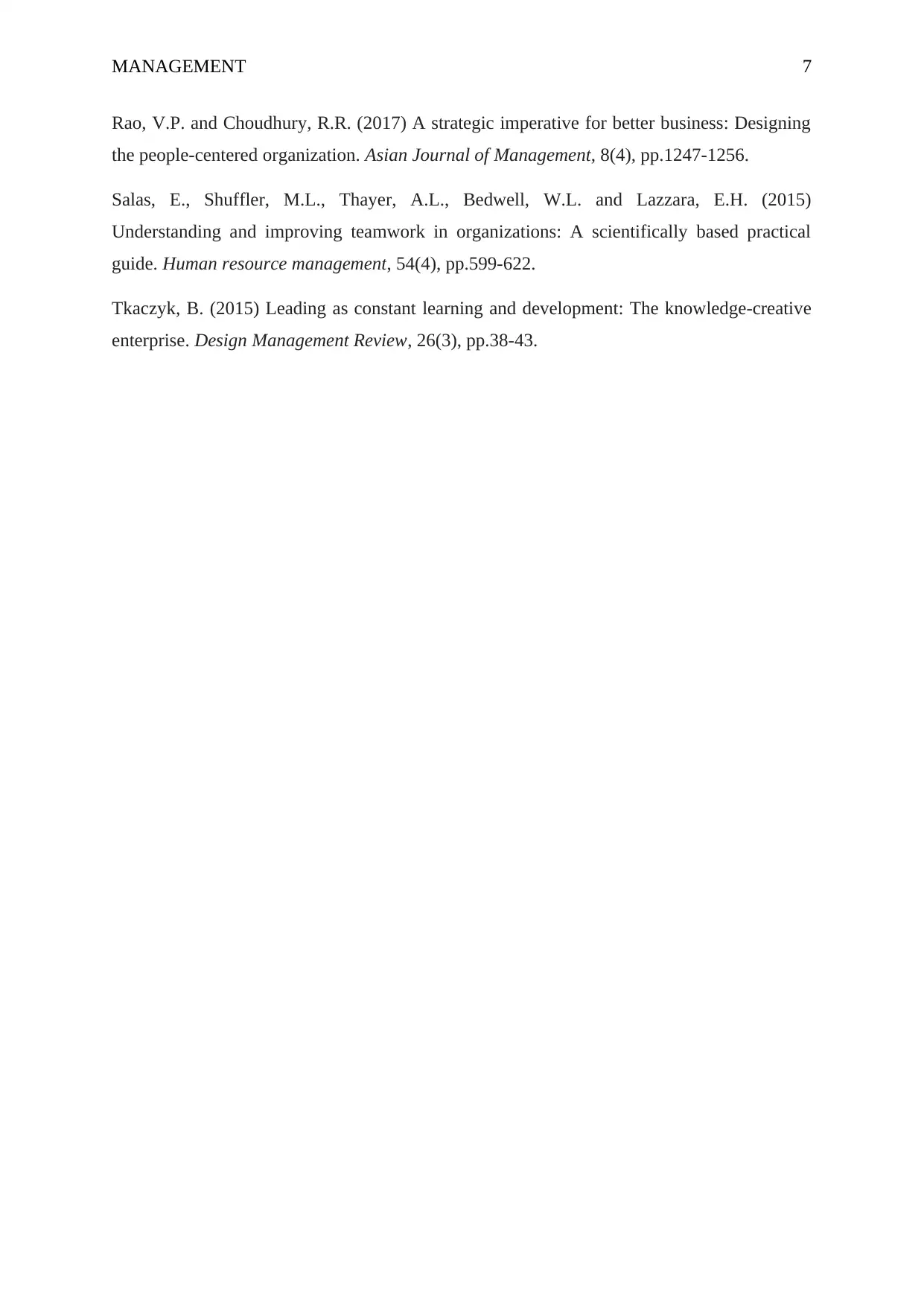
MANAGEMENT 7
Rao, V.P. and Choudhury, R.R. (2017) A strategic imperative for better business: Designing
the people-centered organization. Asian Journal of Management, 8(4), pp.1247-1256.
Salas, E., Shuffler, M.L., Thayer, A.L., Bedwell, W.L. and Lazzara, E.H. (2015)
Understanding and improving teamwork in organizations: A scientifically based practical
guide. Human resource management, 54(4), pp.599-622.
Tkaczyk, B. (2015) Leading as constant learning and development: The knowledge‐creative
enterprise. Design Management Review, 26(3), pp.38-43.
Rao, V.P. and Choudhury, R.R. (2017) A strategic imperative for better business: Designing
the people-centered organization. Asian Journal of Management, 8(4), pp.1247-1256.
Salas, E., Shuffler, M.L., Thayer, A.L., Bedwell, W.L. and Lazzara, E.H. (2015)
Understanding and improving teamwork in organizations: A scientifically based practical
guide. Human resource management, 54(4), pp.599-622.
Tkaczyk, B. (2015) Leading as constant learning and development: The knowledge‐creative
enterprise. Design Management Review, 26(3), pp.38-43.
1 out of 8
Related Documents
Your All-in-One AI-Powered Toolkit for Academic Success.
+13062052269
info@desklib.com
Available 24*7 on WhatsApp / Email
![[object Object]](/_next/static/media/star-bottom.7253800d.svg)
Unlock your academic potential
Copyright © 2020–2025 A2Z Services. All Rights Reserved. Developed and managed by ZUCOL.





